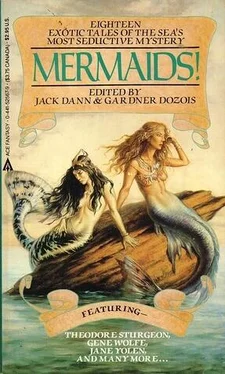Гарднер Дозуа - Mermaids!
Здесь есть возможность читать онлайн «Гарднер Дозуа - Mermaids!» весь текст электронной книги совершенно бесплатно (целиком полную версию без сокращений). В некоторых случаях можно слушать аудио, скачать через торрент в формате fb2 и присутствует краткое содержание. Год выпуска: 1986, ISBN: 1986, Издательство: Ace, Жанр: Фантастика и фэнтези, на английском языке. Описание произведения, (предисловие) а так же отзывы посетителей доступны на портале библиотеки ЛибКат.
- Название:Mermaids!
- Автор:
- Издательство:Ace
- Жанр:
- Год:1986
- ISBN:0-441-52567-9
- Рейтинг книги:5 / 5. Голосов: 1
-
Избранное:Добавить в избранное
- Отзывы:
-
Ваша оценка:
- 100
- 1
- 2
- 3
- 4
- 5
Mermaids!: краткое содержание, описание и аннотация
Предлагаем к чтению аннотацию, описание, краткое содержание или предисловие (зависит от того, что написал сам автор книги «Mermaids!»). Если вы не нашли необходимую информацию о книге — напишите в комментариях, мы постараемся отыскать её.
Mermaids! — читать онлайн бесплатно полную книгу (весь текст) целиком
Ниже представлен текст книги, разбитый по страницам. Система сохранения места последней прочитанной страницы, позволяет с удобством читать онлайн бесплатно книгу «Mermaids!», без необходимости каждый раз заново искать на чём Вы остановились. Поставьте закладку, и сможете в любой момент перейти на страницу, на которой закончили чтение.
Интервал:
Закладка:
1565. "The 18th of November we came to Thora, which Citie is on the shoare of the Red Sea, of no lustre; the Haven small, in which ships laden with Spices out of Arabia, Abassia, and India resort. In this citie we saw a mermaids skin taken there ... which in the lower part ends Fish-fashion: of the upper part, onely the Navill and Breasts remaine; the arms and head being lost."—So no report about the hair.
We now enter the 17th century; date: 1608, chronicler Hendrik Hudson, on his second voyage: "The 15th of June all day and night cleere sunshine... latitude ... 75 deg. 7 minutes... One of our companie ... saw a Mermaid ... From the Navill upward, her backe and breasts were like a woman's... her body as big as one of us; her skin very white; and long haire hanging down behinde, of colour blacke; in her going downe they saw her tayle, which was like the tayle of a Porposse, and speckled like a Macrell. Their names that saw her were Thomas Hilles and Robert Raynar." Benwell and Waugh quote the comments of Philip Gosse. "Seals and walruses must have been as familiar to these polar sailors as cows to a milkmaid. Unless the whole story was a concocted lie between the two men, reasonless and objectless, and the worthy old navigator doubtless knew the character of his men, they must have seen some form of being as yet unrecognized."
Same year: 1608. One Captain Whitbourne relates, "...of a morning early as I was standing by the waterside in the Harbour of St. Johns [Newfoundland]... I espied verie swiftly ... swimming towards me, looking cheerfully, as it had beene a woman, by the Face, Eyes, Nose, Mouth, Chine, Eares, Necke and Forehead: It seemed to be so beautiful and in those parts so well proportioned ... the shoulders and backe downe to the middle, to be as square, white and smooth as the back of a man, and from the middle to the hinder part, pointing in proportion like a broad hooked Arrow... whether it were a Mermaide or no, I know not; I leave it to others to judge..."
1614. Captain John Smith, the same whose adventures with Pocahontas excited us in the first grade, seemed like the actions of a familiar friend in the second, and had begun to bore us by the third; Captain John Smith, a-sailing in the West Indies, saw something "swimming with all possible grace near the shore. The upper part of her body resembled that of a woman ... she had large eyes, rather too round, a finely-shaped nose (a little too short), well-formed ears, rather too long,"—picky, picky Captain Smith!—"... and her green hair imparted to her an original character by no means unattractive... [but] from below the waist the woman gave way to the fish."
1619. A merman is captured off the coast of Norway by two senators, names Ulf Rosensparre and Christian Hollh, and then released. Perhaps he could vote.
1670. Here is the account of the Rev. Lucas Debes, Provost of the Lutheran churches in the Faroes Islands of Denmark. "There was seen ... by many of the inhabitants ... a Mer-maid close to the shore... She had long hair on her head, which hung down to the surface of the water all round about her. She held a fish... in her right hand."
Really, the reported sightings are too numerous to relate without fatigue, so from the 1700's I now mention only one. In 1739, as reported in the distinguished publication The Gentleman's Magazine , "some fisherman near the City of Exeter drawing their nets ashore, a Creature leap'd out, and run away very swiftly; not being able to overtake it, they knock'd it down by throwing sticks after it. At their coming up to it, it was dying, having groan'd like a human Creature: Its Feet were webb'd like a Duck's, it had Eyes, Nose and Mouth resembling those of a man, only the Nose somewhat depress'd; a Tail not unlike a Salmon's, turning up towards its Back, and is 4 Feet high. It was publickly shewn here."
And so we come to the 19th century.
Mr. William Munro, a Scotch schoolteacher (and a school-teacher in Scotland was traditionally expected to be of superior qualifications and was held in great respect, until at least recently being called the dominie , from the Latin, lord ), writes a letter to a Dr. Torrance in Glasgow; letter being published in The Times of London on Sept. 8, 1809.
"About 12 years ago ... when I was Parochial Schoolmaster at Reay, in the course of my walking on the shore of Sandside Bay... my attention was arrested by the appearance of a figure resembling an unclothed human female, sitting upon a rock extending into the sea, and apparently in the action of combing its hair, which flowed around its shoulders, and of a light brown colour. The resemblance which the figure bore to its prototype in all its visible parts was so striking, that had not the rock on which it was sitting been dangerous for bathing, I would have been constrained to have regarded it as really an human form, and to an eye unaccustomed to the situation, it must have undoubtedly appeared as such ... the forehead round, the face plump, the cheeks ruddy, the eyes blue, the mouth and lips of a natural form... the breasts and abdomen, the arms and fingers, from the action in which the hands were employed, did not appear to be webbed, but as to this I am not positive. It remained on the rock three of four minutes after I observed it ... combing its hair... and then dropped into the sea... whence it did not reappear to me. I had a distinct view of its features, being at no great distance on an eminence above the rock where it was sitting, and the sun brightly shining.
"Immediately before its getting into its natural element it seemed to have observed me... It may be necessary to remark, that previous to the period I beheld this object, I had heard it frequently reported by several persons, and some of them persons whose veracity I never heard disputed, that they had seen such a phenomenon as I have described, though then, like many others, I was not disposed to credit their testimony... I can say of a truth, that it was only by seeing the phenomenon, I was perfectly convinced of its existence.
"If the above narrative can in any degree be subservient towards establishing the existence of a phenomenon hitherto almost incredible to naturalists, or to remove the skepticism of others, who are ready to dispute everything which they cannot fully comprehend, you are welcome to it, from,
"Dear Sir,
"Your most obliged and most humble servant,
"William Munro."
I have quoted from this at length, and I am not disposed to doubt that Mr. Munro saw exactly what he said he saw. I am disposed only to ask, What on earth persuaded him that he had seen a mermaid? He says he did not think her fingers were webbed; he says he was close enough to see that her eyes were blue; he certainly saw no tail or else he would certainly have said so: Why did he think he saw a mermaid? As he is not available to ask, I must answer for myself. As follows: (1) She was by the sea, or mer . (2) She was mother-naked. (3) She sat on a rock which was "dangerous for bathing." (4) She was combing her hair, an action traditional for mermaids. (5) She dived into the sea, and did not reappear to him. And that is all.
To me the matter in no way enters the realm of the unnatural, the supernatural, the supranatural, preternatural, or even the mysterious. A Scotch woman, in good health, and tired of all those long, long (and mostly woolen) clothes, decides to go skinny-dipping; there being no facilities for such at that time and in that place, other than the sea itself, into the sea she goes. Coming oot, there being also no bathing caps in them days, she sits herself doon upon a rock, and she cambs her hair and spreads it oot to dry. One would think she might have been private there, but no: alang comes some silly old dominie, and gapes at her: so into the sea she dives again... nae doot hiding under a shelving she knows of till the gowk has passed—
Читать дальшеИнтервал:
Закладка:
Похожие книги на «Mermaids!»
Представляем Вашему вниманию похожие книги на «Mermaids!» списком для выбора. Мы отобрали схожую по названию и смыслу литературу в надежде предоставить читателям больше вариантов отыскать новые, интересные, ещё непрочитанные произведения.
Обсуждение, отзывы о книге «Mermaids!» и просто собственные мнения читателей. Оставьте ваши комментарии, напишите, что Вы думаете о произведении, его смысле или главных героях. Укажите что конкретно понравилось, а что нет, и почему Вы так считаете.











![Гарднер Дозуа - Книга Мечей (сборник) [litres с оптимизированной обложкой]](/books/427839/gardner-dozua-kniga-mechej-sbornik-litres-s-opti-thumb.webp)